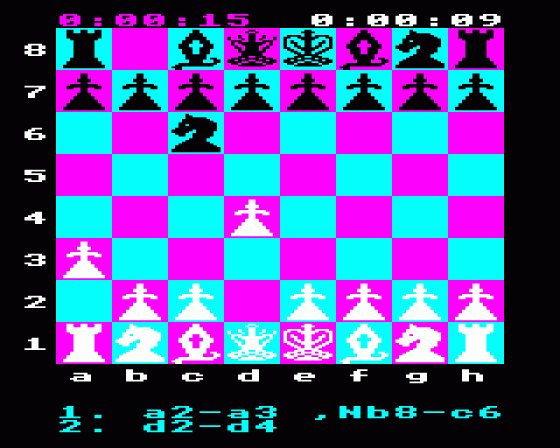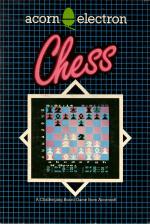
Acorn User
 1st January 1984
1st January 1984
Categories: Review: Software
Author: John Vaux
Publisher: Acornsoft
Machine: Acorn Electron
Published in Acorn User #018
In the March issue of Acorn User, the three chess programs then available for the BBC Micro were reviewed. Since then two others have been released, one from Acornsoft (at last - this was expected nearly a year ago) and one from BBCSoft. The original article gives details of the tests which were done. However, in case you haven't read it, the six positions with which the programs were tested are shown again.
The Acornsoft program, called simply Chess, comes in the familiar, well-packaged style and the BBCSoft box is almost identical. Documentation is good in both cases, a six-page and twelve-page booklet respectively. Unlike some of the arcade-type games, the picture on the front of the Acornsoft box is a true representation of the screen display. The BBCSoft program is White Knight Mk II.
Chess has a main menu and an editor menu which makes it easy to use and after a while the booklet becomes superfluous. White Knight has less helpful information on screen, so reference to the booklet is needed, especially on returning to the game after using another program. Both have all the facilities needed for normal play and for setting up problem positions, clocks, and the ability to save and recall games. The displays of the board and pieces are good, particularly the Acornsoft version, and compare well with the three older programs. As well as showing the last few moves, White Knight also gives the current best line found, the ply being searched to and, at the end, displays the number of positions examined. This latter information disappears rather quickly.

Chess and White Knight allow moves to be entered either by keying in the from and to board positions in normal algebraic notation of by using the cursor keys to select the positions on the board. Chess can also use joysticks, but in both games setting up a position is very easy.
Levels of play are set differently. Chess has ten levels from 0 (easy) to 9 (very difficult), while White Knight levels are based on time - average move time may be set up to 59 minutes 59 seconds. It can be set to play at the same speed as its human opponent. Both programs have a special mode for chess problems to reach mate in so many moves. Mate in five moves, is allowed, i.e. nine-ply - potentially very powerful, but see later. None of the earlier programs has this feature.
Like the earlier programs neither of these have an opening book. They seem to prefer knight openings and are soon away from the standard lines. However, their opening moves are usually quite sound.

As explained in the earlier article, set problems as published in chess books are a good test of how well chess programs play. I have used the same set of problem benchmarks as before with a few additions.
Mate in two moves (three-ply): Each program was given nine problems. The best of the earlier programs (Micro Power) solved all nine correctly in times from ten seconds to eight minutes. Acornsoft solved all nine in problem mode in four seconds to just over one minute - considerably faster than the Micro Power version. White Knight solved them all in problem mode in less than one second each! Figures 1 and 2 are two of these problems. Solutions are: A4-E4 check, B7xE4, D3xE4 mate; and D5-A8 check, C8-C7, A8-B7 mate respectively.
Mate in three moves (five-ply): Micro Power was the only one of the earlier programs considered good enough to tackle these. Its times were 49 minutes for one problem (figure 3) and nearly three hours for another, both solved correctly. Acornsoft did the first one in 35 minutes. White Knight - and this is the amazing thing! - did this one in fifteen seconds! It did other mate-in-three problems in six seconds, 13 seconds and 19 seconds. The solution to figure 3 is: E8-H8 check, H7xH8; E3-H6 check, H8-G8; H6xG7 mate.
White Knight was so good that it was given three mate-in-four (seven-ply) problems. It solved these in four minutes, eight minutes and ten minutes. Any of the other programs would have taken hours.
Both the new programs were faster solving problems in problem mode than playing normally. For instance, for one of the mate-in-two problems, Acornsoft took 24 seconds in problem mode and needed level four to get the correct answer in over two minutes. White Knight took one second and four seconds respectively.
Now for the special problems in figures 4, 5 and 6. Both Acornsoft and White Knight failed to solve figure 4. The answer is to let black promote the pawn, exchange it with the queen, then easily win with the four-to-nil pawn advantage. The answer to figure 5 is to promote to a knight rather than the usual queen, thereby forking the king and queen. Acornsoft was correct. White Knight was not, presumably because it is programmed only to promote to a queen.
Figure 6 shows an endgame pawn-king race situation. In this case the king cannot catch the A-pawn before it promotes but can catch the B-pawn. So the answer is to advance the A-pawn. White Knight could not solve this, even at its highest level. Acornsoft solved in at level six in 30 seconds. Bug Byte was the best of the earlier programs, solving it in 24 seconds.
On this occasion I had no access to a chess machine so could not try actual games. Playing them myself would have been too variable - I am a very inconsistent player!
To summarise, there still isn't a perfect chess program for the BBC Micro. White Knight is fast, particularly in problem mode. The display shows it to be examining positions at over 50,000 per minute! It has its limitations as mentioned above, but I would still rate it as the best buy. I would rate Acornsoft and Micro Power about the same as second choice.
The problems were taken from How to Get The Most From Your Chess Computer by Julio Kaplan, The Computer Chess Book by T. Harding and Rate Your Own Chess by F. Donald Boss.



